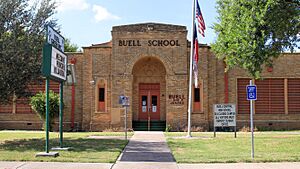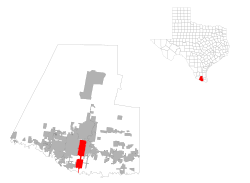Pharr, Texas facts for kids
Quick facts for kids
Pharr, Texas
|
||
|---|---|---|

The Buell School in Pharr, which was designated a Recorded Texas Historic Landmark in 1990.
|
||
|
||

Location of Pharr, Texas
|
||
| Country | ||
| State | ||
| County | Hidalgo | |
| Incorporated | February 22, 1916 | |
| Government | ||
| • Type | Council-manager | |
| Area | ||
| • Total | 23.65 sq mi (61.26 km2) | |
| • Land | 23.63 sq mi (61.19 km2) | |
| • Water | 0.03 sq mi (0.07 km2) | |
| Elevation | 112 ft (34 m) | |
| Population
(2020)
|
||
| • Total | 79,715 | |
| • Estimate
(2022)
|
80,187 | |
| • Density | 3,348.51/sq mi (1,292.85/km2) | |
| Time zone | UTC-6 (Central (CST)) | |
| • Summer (DST) | UTC-5 (CDT) | |
| ZIP code |
78577
|
|
| Area code(s) | 956 | |
| FIPS code | 48-57200 | |
| GNIS feature ID | 1343930 | |
Pharr is a suburb of McAllen, Texas in Hidalgo County, Texas, United States. As of the 2020 census, the city population was 79,715, and in 2022, the estimated population was 80,187. Pharr is connected by bridge to the Mexican city of Reynosa, Tamaulipas. Pharr is part of the McAllen–Edinburg–Mission and Reynosa–McAllen metropolitan areas.
Contents
Geography
Pharr is located in southern Hidalgo County at 26°12′23″N 98°11′7″W / 26.20639°N 98.18528°W (26.206334, –98.185174). It is bordered to the west by the city of McAllen, to the north by Edinburg, the county seat, to the east by San Juan, and to the southwest by Hidalgo. The Pharr city limits extend south in a narrow band to the Rio Grande and the Pharr–Reynosa International Bridge into Mexico.
According to the United States Census Bureau, Pharr has a total area of 23.4 square miles (60.7 km2), of which 0.03 square miles (0.07 km2), or 0.12%, is covered by water.
Communities:
- Las Milpas (annexed in 1987)
History
The community was named after sugar planter Henry Newton Pharr (1872-1966). For a number of years, centering around early 1900, Henry N. Pharr was director of the State National Bank of New Iberia, Louisiana, and was a former president of the Louisiana–Rio Grande Sugar Company and the Louisiana–Rio Grande Canal Company, which at one time owned 8,000 acres (32.4 km2) and which, in 1910, built the town of Pharr on this land. Pharr was the Republican nominee for Louisiana governor in 1908, as his father John Newton Pharr had been in 1896.
Pharr has grown rapidly since the late 20th century, from a population of 32,921 in 1990 to an estimated 77,320 in 2016 and 79,112 in 2019.
In 1987, Pharr annexed Las Milpas.
In 2006, Pharr received "The All-America City" award.
Climate
Pharr has a humid subtropical climate, similar to that of the Tampa Bay Area of Florida, but with less precipitation and slightly higher summer maximum temperatures. The average high in January is 68 °F (20 °C), and the average low is 47 °F (8 °C). In August, the average high is 100 °F (38 °C), and the average low is 80 °F (27 °C). The warm season is long, with average highs and lows similar to August's from June through September.
The average annual precipitation is 21.0 inches (530 mm). Most precipitation occurs in the warm season, with the least precipitation distinctly occurring in the cooler winter. As September is the peak of the north Atlantic hurricane season and tropical storms and hurricanes occasionally drop copious amounts of rainfall on the region, this month tends to be by far the wettest, averaging 3.6 inches (91 mm) of precipitation. The driest month is March, with 0.7 inches (18 mm) of precipitation.
Despite frequent temperatures above 100 °F (38 °C), occasionally as early as February and as late as the end of October, the highest temperature ever recorded in Pharr is 110 °F (43 °C), once in 1998 and once in 1999. The lowest temperature ever recorded in Pharr is 13 °F (−11 °C), on January 12, 1962, which is far lower than would be expected at the same latitude in Florida or on the west coast of North America, due to Pharr's location closer to the middle of the continent.
Demographics
| Historical population | |||
|---|---|---|---|
| Census | Pop. | %± | |
| 1920 | 1,565 | — | |
| 1930 | 3,225 | 106.1% | |
| 1940 | 4,784 | 48.3% | |
| 1950 | 8,690 | 81.6% | |
| 1960 | 14,106 | 62.3% | |
| 1970 | 15,829 | 12.2% | |
| 1980 | 21,381 | 35.1% | |
| 1990 | 32,921 | 54.0% | |
| 2000 | 46,660 | 41.7% | |
| 2010 | 70,400 | 50.9% | |
| 2020 | 79,715 | 13.2% | |
| U.S. Decennial Census | |||
2020 census
| Race | Number | Percentage |
|---|---|---|
| White (NH) | 3,733 | 4.68% |
| Black or African American (NH) | 134 | 0.17% |
| Native American or Alaska Native (NH) | 23 | 0.03% |
| Asian (NH) | 293 | 0.37% |
| Pacific Islander (NH) | 3 | 0.0% |
| Some Other Race (NH) | 172 | 0.22% |
| Mixed/Multi-Racial (NH) | 158 | 0.2% |
| Hispanic or Latino | 75,199 | 94.33% |
| Total | 79,715 |
As of the 2020 United States census, there were 79,715 people, 22,668 households, and 18,420 families residing in the city.
Transportation
Highways
- Pharr has I-2/U.S. 83 as its major east–west artery. U.S. 281 runs north–south through the city and intersects I-2/U.S. 83 at the center of the city and continues south to the Pharr-Reynosa International Bridge. From I-2/U.S. 83 at the center of the city north to Edinburg (and eventually to George West), U.S. 281 is co-signed with I-69C.
Education
Primary and secondary schools
The majority of Pharr is served by the Pharr-San Juan-Alamo Independent School District, which has five high schools in the city: PSJA North Early College High School, PSJA Southwest Early College High School, Thomas Jefferson TSTEM Early College High School, PSJA Sonia M. Sotomayor Early College High School, and Buell Central DAEP. Zoned PSJA ISD schools include PSJA North and PSJA Southwest.
A small fringe portion of the city is a part of the Hidalgo Independent School District. Another small portion is a part of the Valley View Independent School District, which has one campus with around 2,000 students.
In addition, residents are allowed to apply to magnet schools operated by the South Texas Independent School District.
Area colleges and universities
- University of Texas Rio Grande Valley in Edinburg
- South Texas College in McAllen
Public libraries
Pharr Memorial Library serves the city.
Sister cities
 San Luis Potosí, San Luis Potosí, Mexico
San Luis Potosí, San Luis Potosí, Mexico- Zacualpan de Amilpas, Tetela del Volcan, and Ocuituco, Morelos, Mexico.
Notable people
- Leo Araguz — former NFL punter and kicker
- Pedro Borbón — relief pitcher for Major League Baseball
- Cali Carranza — Tejano musician
- Carlos Diego Ferreira — Brazilian mixed martial arts and former Legacy FC
- Omar Ontiveros — professional soccer player
- Baldemar Velasquez — labor-union activist
See also
 In Spanish: Pharr (Texas) para niños
In Spanish: Pharr (Texas) para niños


